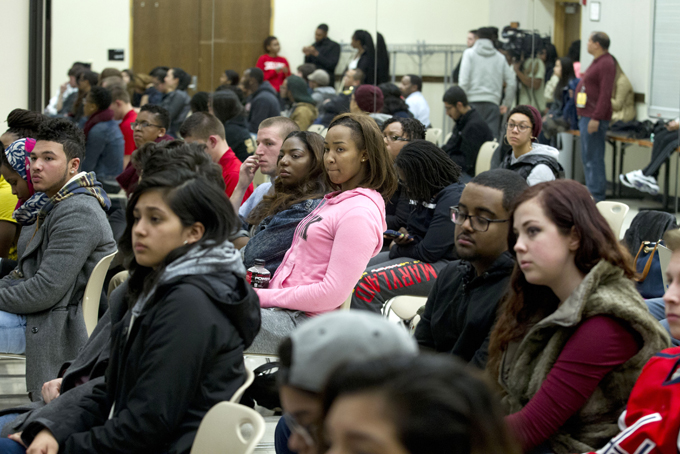
COLLEGE PARK, Md. (AP) — Kayla Tarrant loves the University of Maryland. But the campus tour guide says a racist email and photo attributed to her schoolmates makes her reluctant to encourage other Black students to enroll “in a place where you feel unsafe and no one cares about you.”
“We’re literally begging people to care about our issues,” Tarrant said, with tears in her eyes, to applause from about 100 students — Blacks, Hispanics, Asians and a few Whites — gathered to discuss the racial climate at the predominantly White, 27,000-student campus.
Conversations like the recent one at Maryland’s Nyumburu Cultural Center are taking place nationwide as racist incidents continue to pop up at colleges and universities, even though students are becoming increasingly vocal in protesting racism and administrators are taking swift, zero-tolerance action against it.

This week alone, Bucknell University expelled three students for making racist comments during a March 20 campus radio broadcast. At Duke University, a noose was found hanging from a tree.
“I just want to say that if your intent was to create fear, it will have the opposite effect,” said Larry Moneta, vice president for student affairs at Duke. Officials have since accused a student in the incident but have declined to release the student’s name or race.
This is happening against a backdrop of promise when it comes to race relations, with campuses enrolling record numbers of Black and Hispanic millennials. The current college generation — young people who came of age under the nation’s first Black president — is said to have more accepting racial attitudes, but putting an end to racism among them has proved elusive.
The Bucknell and Duke incidents came days after spray-painted swastikas and nooses were found at dorms on the State University of New York’s Purchase campus. A former University of Mississippi student was indicted on federal civil rights charges last week, accused of tying a noose on the statue of the university’s first Black student and draping it with an old Georgia state flag that includes a Confederate battle emblem.
Social media have stoked the issue, with top administrators at Kansas State, the University of Northern Iowa and the University of Missouri urging students to stop posting anonymous racist speech on apps.
The wide usage of sharable video has also been a factor. In February, students at the University of Oklahoma were caught on video singing a chant that included references to lynching and used a racial slur to describe how the Sigma Alpha Epsilon fraternity would never accept black members.
“We had an epidemic of racism all across our country,” University of Oklahoma President David Boren, who banned the fraternity from campus, said in a news conference. “Ferguson, Missouri, might be the best-known case, but it’s all across our country every day, every week.”
Even before the Oklahoma incident, a little more than half — 51 percent — of college and university presidents in an Inside Higher Ed poll conducted this year by Gallup rated race relations on college campuses as “fair.”
Tasia Harris, a senior at the University of North Carolina at Chapel Hill, said racially charged events in society are “blatant reminders that this is something that continues to affect our lives.” She is among students who are trying to get a plaque placed next to a Confederate soldier statue on her campus, explaining its history.
“White supremacy isn’t just in Ferguson or isn’t just in New York or isn’t just Cleveland or where have you. It’s also in these very privileged sites,” said Omololu Babatunde, a North Carolina senior.
The Pew Research Center work has found that millennials are more likely than older generations to say society should make every possible effort to improve the position of Blacks and other minorities. They are also more likely to support interracial marriage and have friends of other races. Such data also shows divides. Little more than half of White and Black millennials in one Pew survey said all, most or some of their friends are Black or White, respectively.
And among millennials age 18-24, a 2012 Public Religion Research Institute/Georgetown University poll found 56 percent of White millennials said the government has paid too much attention to the problems of minorities over the past few decades. About a quarter of Black respondents and 37 percent of Hispanics agreed.
In 1976, nearly 10 percent of students were African-American and 4 percent were Hispanic. In 2013, nearly 15 percent were Black and nearly 16 percent Hispanic. The National Center for Education Statistics projects such growth will continue.
Benjamin Reese, president of the National Association of Diversity Officers in Higher Education, said efforts to put appropriate focus on the issue of diversity has unintentionally “diluted the focus on the unfinished business regarding race.”
At the University of Maryland, a student resigned from Kappa Sigma fraternity this year after being suspended after a 2014 email containing racially and sexually suggestive language about Black, Indian and Asian women was made public. This followed an Instagram photo of a University of Maryland sorority member late last year with a birthday cake containing racially explicit text.
University administrators say they are addressing students’ concerns and point to holding open forums, creating a multicultural student advisory group to advise the college president and educating Greek members about topics such as “multicultural competency.”
Kumea Shorter-Gooden, the chief diversity officer at the University of Maryland, hopes the dialogue “will help us all to get to a better place, but we’ve got to stick with it.”
“There’s no quick fix,” she said.
___
Hefling reported from Washington. Associated Press News Survey Specialist Emily Swanson contributed to this report.
___
Kimberly Hefling covers education. Jesse J. Holland covers race and ethnicity for The Associated Press. Follow them on Twitter at https://www.twitter.com/khelfing and https://www.twitter.com/jessejholland.